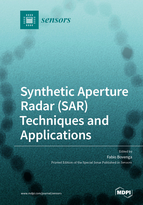Synthetic Aperture Radar (SAR) Techniques and Applications
A special issue of Sensors (ISSN 1424-8220). This special issue belongs to the section "Remote Sensors".
Deadline for manuscript submissions: closed (30 June 2019) | Viewed by 73698
Special Issue Editor
Interests: synthetic aperture radar (SAR) processing; SAR interferometry; ground deformation monitoring; signal processing
Special Issues, Collections and Topics in MDPI journals
Special Issue Information
Dear Colleagues,
Synthetic Aperture RADAR (SAR) became a well-established and powerful remote sensing technology used worldwide for several applications thanks to the possibility of sensing the Earth surface at night and day and in any weather condition. Recent advances have dramatically raised on SAR monitoring potential by improving spatial resolution, revisit time, swath width, polarimetric capability. Moreover, the present and forthcoming space-borne missions allow SAR imaging at different bands and acquisition modes (e.g. spotlight, wide swath, bistatic, multistatic, geosynchronous). All these advances stimulated the investigation of new processing algorithms, products, and applications able to fully exploit new sensor capabilities (e.g. wide spectral band, short revisit time, multi-angle view), and the large SAR data archive.
Based on this, papers are requested, dealing with the following research issues concerning both algorithm developments and applicative examples:
- Innovative SAR sensors, concepts, and acquisition modes;
- innovative SAR products;
- SAR signal modeling, simulation, and processing;
- SAR imaging from Unmanned Aerial Vehicles (UAV), ground based sensors, and geosynchronous platforms;
- advances in SAR polarimetry, SAR across/along track interferometry, and SAR tomography;
- new opportunities for SAR applications to land, sea, and natural disasters.
Dr. Fabio Bovenga
Guest Editor
Manuscript Submission Information
Manuscripts should be submitted online at www.mdpi.com by registering and logging in to this website. Once you are registered, click here to go to the submission form. Manuscripts can be submitted until the deadline. All submissions that pass pre-check are peer-reviewed. Accepted papers will be published continuously in the journal (as soon as accepted) and will be listed together on the special issue website. Research articles, review articles as well as short communications are invited. For planned papers, a title and short abstract (about 100 words) can be sent to the Editorial Office for announcement on this website.
Submitted manuscripts should not have been published previously, nor be under consideration for publication elsewhere (except conference proceedings papers). All manuscripts are thoroughly refereed through a single-blind peer-review process. A guide for authors and other relevant information for submission of manuscripts is available on the Instructions for Authors page. Sensors is an international peer-reviewed open access semimonthly journal published by MDPI.
Please visit the Instructions for Authors page before submitting a manuscript. The Article Processing Charge (APC) for publication in this open access journal is 2600 CHF (Swiss Francs). Submitted papers should be well formatted and use good English. Authors may use MDPI's English editing service prior to publication or during author revisions.
Keywords
- New SAR sensors / concepts
- New SAR acquisition modes
- New SAR products
- SAR image processing
- SAR signal modeling and simulation
- SAR imaging from Unmanned Aerial Vehicles (UAV)
- Ground based SAR
- Geosynchronous SAR
- SAR polarimetry
- Across / along track SAR interferometry
- SAR tomography
- SAR for land applications
- SAR for sea applications
- SAR for natural disasters







